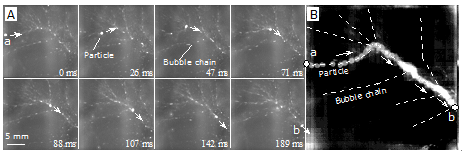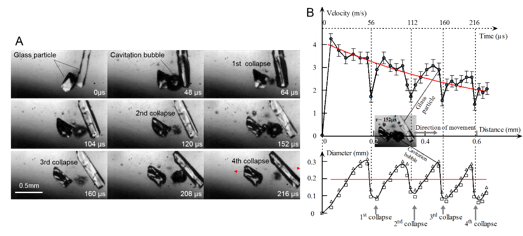When the ultrasonic amplitude exceeds a specific threshold, cavitation will occur in the ultrasonic field. There are some phenomena or applications of mass transport which are related to cavitation bubble vibration. Most of the researches about the ALF (Acoustic Lichtenberg Figure) cavitation structures are concerning deformation, motion, and distribution of cavitation bubbles. Up to now, there is no investigation of motion of solid particles in ALF structures. Unlike the material transport mentioned above, the transport of particles in the cavitation cloud is greatly influenced by the ultrasonic field, the cavitation bubbles and the cavitation structure simultaneously.
In order to solve the problem, researchers from the Institute of Acoustics of the Chinese Academy of Sciences (IACAS) investigated the directional transport and random motion of particles in ALF ultrasonic cavitation structure with experiments.

Figure.1. The transportation of a wax particle in an ALF structure. (A) Snapshots from a video of this experiment. (B) A composite image of superimposing the snapshots from the video sequence. (Image by IACAS)
One of the most important characteristics of ALF cavitation structure is the existence of cavitation bubble chains. A large number of cavitation bubbles are arranged into a bubble chain structure in the process of radial vibration and translational motion. Bubbles line up, and then move along the bubble chains. These chains interweave with each other and assemble to form a branch structure (ALF). This is mainly due to the interaction of the standing wave sound field, the primary Bjerknes force and the secondary Bjerknes force. When a solid particle is put into the ALF cavitation structure (gas-liquid two-phase medium), it is found that the solid particle moved translationally. The trajectory of the particle is almost coincident with that of cavitation bubbles.

Figure.2. Particles bounce off each other due to cavitation bubbles. (A) Snapshots from a video of the experiment. (B) Variation of bubble diameter and particle velocity with position. (Image by IACAS)
Particles tend to move towards the focus. Particles are not fixed at the focus, they aggregate and separate alternately over time. The dominant forces in dispersion and aggregation are different. The separation of particles mainly occurs in the expansion process of cavitation bubbles, while the movement and aggregation of particles mostly take place during the collapse stage.
The directional transport of particles along the bubble chain of ALF cavitation cloud and the random aggregation and dispersion at the focus of ALF are all related to the cavitation bubbles attached to the particles. The main mechanism of particles separation is particles bounce off each other during cavitation expansion, independent of shock wave or microjet induced by the cavitation collapse. The secondary Bjerknes force only works when the two particles with cavitation bubbles attached are relatively close. The directional transportation (predictable, repeatable and pipeline-free) and aggregation of particles in ALF cavitation clouds may be used in special occasions, for example, drug delivery and targeted therapy.
The research, published online in Ultrasonics Sonochemistry, is supported by the National Natural Science Foundation of China (Nos.11874062 and 11674350).
Reference:
MA Yuhang; ZENG Zhijie; XU Weilin; BAI Lixin. Directional transport and random motion of particles in ALF ultrasonic cavitation structure. Ultrasonics Sonochemistry, 2021, 72: 105439, 1-7. DIO: 10.1016/j.ultsonch.2020.105439
Contact:
ZHOU Wenjia
Institute of Acoustics, Chinese Academy of Sciences, 100190 Beijing, China
E-mail: media@mail.ioa.ac.cn


